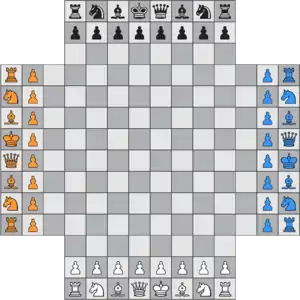Four-player chess
Four-player chess (also known as Four-handed, Four-man, or Four-way chess) is a family of chess variants typically played with four people. A special board made of standard 8×8 squares with an additional 3 rows of 8 cells extending from each side is common. Four sets of differently colored pieces are needed to play these variants. Four-player chess follows the same basic rules as regular chess. There are many different rule variations; most variants, however, share the same board and similar piece setup.
 A popular four-player chessboard and initial setup | |
| Genre(s) | Abstract strategy game Chess variant |
|---|---|
| Players | 4 |
| Random chance | None |
| Skill(s) required | Strategy, tactics |
| Synonym(s) | Four-handed chess Four-man chess Four-way chess Battle-Chess |
Gameplay can be in teams, but it can also be a free-for-all, with each of the players out for themselves. As with regular chess, four-player chess begins with fortifications and the development of pieces, but opportunities for capturing pieces (and gaining points) come about quickly, as each of the three opponents attack and make threats of capture. Therefore, picking friends and enemies has a political quality; ultimately the impromptu teammates will have to combat each other as only one player can win.
History
The Cox-Forbes theory of the origin of chess, though debunked, asserts that a four-player version was the earliest form of the game. A description of a four-player chess game was found in an Indian text written c. 1500. The Tithitattva of Raghunandana describes such a version, which continued to be played into the 20th century.[1]
The first documented example of a modern four-player chess system was written by Captain George Hope Verney in England in 1881.[2]
Team
The most common form of play is two vs. two in which allied pieces cannot eliminate each other, but help the others in defense and offense. The allied players sit across from each other and help checkmate the people to the left and right of them. The game is over when both opposing kings are checkmated. If only one can be checkmated, the game is a draw.
Singles
Singles is substantially harder than team play. In this method, each player can attack any of the other three players and vice versa. Once a player is checkmated, the checkmated player can either remove their pieces from the board, or the player that checkmated can use the remaining pieces during that player's turn. Play continues until only one player remains.
Common game rules
- Players can only move their chess pieces on their turns.
- If a player is placed in check, that player must wait until their designated turn before that player can respond to the threat. However, in most variations, in the event a player's move places an opponent in check at the hands of another opponent (for example, by moving their knight so as to expose one opponent's king to another's rook), the second opponent is forbidden from capturing the first's king until they have a chance to deal with the check. Some variations prohibit moves that would cause one opponent to be in check at the hands of another. These restrictions are intended to discourage collusion between players, as further discussed below.
- Pawns move forward only, unless attacking in a diagonal forward manner.
- In the event a pawn reaches the King's row to the left, right or directly across, that pawn shall receive all the privileges of a pawn reaching King's row during a traditional chess game (i.e. promoting to a queen (most commonly), a rook, a bishop, or a knight).
- It is legal, but should not be communicated, for two or more of the players to team up.
See also
- Fortress chess
- Quatrochess—a variant for four, featuring fairy pieces
- Three-player chess
References
- Partlett, David, The Oxford history of board games, Oxford University Press, 1999, p.281.
- "4 Player Chess". BoardGameGeek. Retrieved 29 September 2012.
Further reading
- Pritchard, D. B. (1994). The Encyclopedia of Chess Variants. Games & Puzzles Publications. ISBN 0-9524142-0-1.
- Pritchard, D. B. (2007). Beasley, John (ed.). The Classified Encyclopedia of Chess Variants. John Beasley. ISBN 978-0-9555168-0-1.